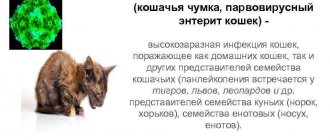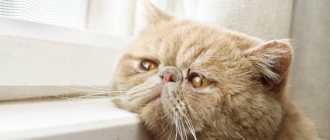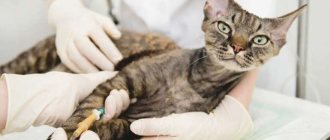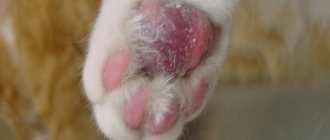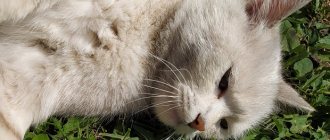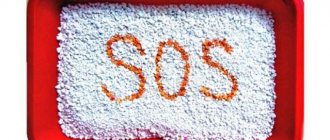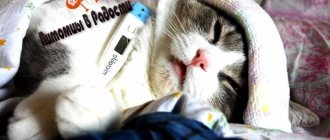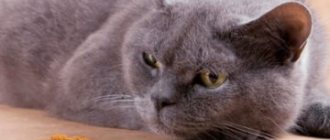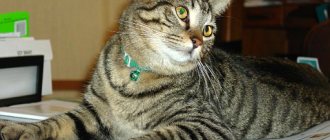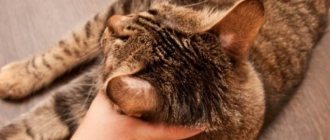Features of the disease
Discharge from the nostrils and eyes is one of the signs of distemper in cats.
Feline distemper, or panleukopenia, is a highly contagious disease. The clinical picture depends on the type of disease, but always manifests itself with fairly clear signs. This is due to the rapid multiplication of the virus in the body, the speed of which largely depends on the state of the immune system. The most vulnerable felines are kittens, pregnant and weakened cats, as well as purebred pets.
The virus that causes distemper in domestic cats is highly resistant to external factors. It can tolerate low and high temperatures; even heating to +60 ˚C can destroy it only after 60 minutes. Disinfectants also cannot destroy pathogenic microorganisms, especially if they are diluted in low concentrations.
Diagnostics, tests
When making a diagnosis, the veterinarian takes into account the medical history, clinical picture, results of ultrasound, CT, MRI, and the epizootological situation in the region. A number of serological, histological, and complex laboratory studies are carried out. For analysis, blood, stool, urine samples, tear secretions, eye and nasal secretions are taken.
Diagnostics includes PCR analysis, ELISA. Special tests are carried out. Due to the similarity of clinical manifestations, a differential diagnosis is mandatory, which makes it possible to establish an accurate diagnosis if panleukopenia is suspected in cats.
How can a cat become infected with distemper?
There are several ways a cat can become infected with the distemper virus. In each of them, the source is the biological secretions of an already sick animal or a carrier of infection.
Infection method
Detailed description
Direct contact
A pet can “catch” the disease by directly touching objects that the sick animal has come into contact with. The virus can enter the house and on the owner’s belongings.
Oral route
Distemper infection will also occur if you eat food or drink that contains the infection.
Through the air
If a healthy cat is in the same room as an infected one, then panleukopenia cannot be avoided.
Through bites
Blood-sucking insects are capable of transmitting the feline distemper virus.
In utero
The feline distemper virus is able to cross the placental barrier. In most cases, fetuses die before birth. If the kittens succeed in being born, then in the near future (no more than two days) they still die.
Many owners are interested in whether a cat can get distemper from a dog? No, he can not. The viruses that cause plague in these animals are completely different.
How does distemper manifest in cats?
The feline distemper virus can infect almost all organ systems: nervous, respiratory, cardiovascular, and digestive tract. Symptoms of the disease depend on which organs the microorganism has managed to damage, on the capabilities of the cat’s immune defense, as well as on the form of the disease, which can be of three types.
Form of the disease
Peculiarities
Symptoms
Lightning fast
It has a particularly high mortality rate as it develops quickly. It is observed mainly in kittens of the first year of life. The smaller the kitten, the faster it dies. The fulminant form is often manifested by disorders of the nervous and digestive systems.
- Refusal to suck, food, water
- Apathetic state
- Avoiding bright light and sharp sounds (when they occur, it begins to squeak loudly)
- Diarrhea, vomiting
- Tousled fur
- Body tremors, convulsions
- Paralysis
Acute
More common in adult cats. The incubation period ranges from 3 to 10-14 days. The clinical picture is varied and depends on the number of affected organs. Mainly the gastrointestinal tract, respiratory system, and heart are affected. With timely contact with specialists and proper treatment, the pet can recover. If no help is provided to the animal in the next 3-5 days after the onset of symptoms, it will die.
- Apathy
- Temperature rises to 41˚
- Vomit contains blood, mucus, and foam
- Despite being thirsty, the cat refuses to drink water
- Skin spots
- Cough, wheezing
- Discharge from nostrils, eyes
- Tachycardia
- Shortness of breath, mouth breathing
- Sunken eyes, tousled, dull coat
Subacute
It is typical for adult mustachioed individuals and cats that have been vaccinated against distemper. The disease may last for 1-3 weeks.
The same as in the acute form of plague, but in a less pronounced form.
What can panleukopenia be confused with?
Firstly, with poisoning. An important difference between panleukopenia and poisoning is that with this disease, at the initial stage of the disease, the animal’s body temperature rises significantly, up to 40-41 degrees and above. In case of poisoning, the temperature is normal or low. However, kittens quickly enter the second phase of the disease - exhaustion of the body, during which the temperature drops. In this case, only a veterinarian can distinguish between these two conditions.
Secondly, with acute toxoplasmosis. Most often, this infection is carried by cats asymptomatically, but in kittens it is difficult to distinguish between these two infections by symptoms. This is where express analysis or PCR comes to the rescue. Toxoplasmosis in kittens, although severe, is less dangerous than panleukopenia. There is a specific treatment for this disease, that is, drugs that kill the pathogen.
Thirdly, with pancreatitis, acute gastroenteritis of non-viral nature and other diseases of the gastrointestinal tract. With these diseases, the temperature may rise, but the pathogen will not be identified, and in small kittens they are all quite rare.
Therapeutic measures
At the first symptoms of distemper, we recommend immediately contacting a veterinarian
Treatment of distemper in cats includes several tasks: destroy the virus, eliminate intoxication, prevent secondary infection, increase immunity, and so on. To combat the virus, drugs such as Vitafel, Fosprenil, Enterostat are used. The administration regimen is prescribed by the veterinarian.
Various drugs are used as a symptomatic treatment for distemper in cats.
- Sodium chloride. The distemper virus causes severe dehydration and intoxication. The body cannot cope with toxins on its own. Intravenous administration of a chloride solution helps restore the balance of water, salts, and minerals.
- As a rule, distemper in cats is accompanied by a secondary infection. To eliminate it, the veterinarian will prescribe antibacterial agents.
- Diuretic fees. To quickly cope with toxic metabolic products and remove them from tissues and the body, decoctions of diuretic herbs and herbs are used. In frequent small portions, you can give your cat a decoction of lingonberries, horsetail, bearberry leaf and others.
- If there is no vomiting, it is recommended to use Regidron or Ringer's solution to normalize the water-mineral balance. The daily amount of solution is calculated based on the ratio of 5 tbsp. l. liquid per 1 kg of animal weight. You can add glucose solution and sodium bicarbonate to the diluted drugs (the proportions must be checked with your veterinarian).
- For pain and spasms in the digestive tract, taking antispasmodics, for example, No-shpa, is indicated.
- Catozal will help strengthen metabolic processes, improve immunity, and stimulate the body to recover. It must be administered within 7 days.
- The treatment complex also includes vitamin supplements, especially antioxidants A and C, and B vitamins. It is advisable to combine their intake with drugs containing iron, for example, Ferrodextran.
Pet treatment
After confirmation of the diagnosis, complex therapy is prescribed, which includes the following groups of drugs:
- painkillers and antispasmodics (No-spa and Dibazol);
- antihistamines;
- antiviral and immunomodulators (Gamavit, Fosprenil, Ribotan, etc.);
- to normalize metabolic processes - Katozal;
- medications to eliminate dehydration (Regidron, Rieger) and restoratives (vitamins, glucose solution, iron supplements);
- antiemetics and to remove toxins (Enterostat at the rate of 20 mg/kg body weight);
- drugs that support cardiac activity (Cordiamin, Caffeine);
- antibiotics to avoid secondary infection;
- diuretics, it is allowed to use folk recipes (decoctions of lingonberry, bearberry, horsetail leaves).
Home care
Proper care at home for a cat with distemper increases the likelihood of a successful recovery. If possible, it is better to give injections by calling a doctor at home, since any stress can negatively affect the animal’s condition. If you have to visit the clinic every day, then for transportation it is better to build a basket yourself (for example, from a cardboard box), so that you can burn it later.
The room where the cat is located should be warm and dry, without draft wind. Since the virus also affects the nervous system, you need to provide your pet with peace and shade with bright light.
You can drink both plain water (boiled) and decoctions of medicinal herbs. Their choice should be previously agreed with your veterinarian, because some medications and plant extracts may be incompatible. You need to feed your pet little by little, at the beginning of treatment - only broths, gradually adding porridge and chopped meat to them. It is recommended to follow a diet until complete recovery.
In agreement with the doctor, it is allowed to give the cat enemas. They may include herbal preparations, decoctions, and antiseptics. The tray and bowls should be placed next to the animal, and the bedding should be changed daily. Washing your pet while sick is not recommended.
Diet
Distemper in cats is a serious disease, so after the animal is cured, it is important for the owner to take care of the appropriate nutrition for his pet. To do this you need to follow some recommendations:
- After the cat's appetite returns, the cat's menu should consist exclusively of light, slightly warm, pureed food.
- It is not recommended to feed your pet against his will - when he gets better, he will start eating on his own.
- Portions should be small, food should be given 5-6 times a day.
- It is allowed to feed low-fat broth, cottage cheese, kefir, and yogurt. After 3 days, you can gradually introduce a little boiled lean beef and fish fillet into the diet.
- Vegetables, fruits, grains, and any raw food are prohibited foods for cats that have just suffered from distemper - such foods can be given no earlier than after 2 months.
Can other animals or humans become infected with feline distemper?
Is a pet with panleukopenia dangerous to others? Cats after distemper are carriers of the virus for 4-5 months and can become its source, but only a feline can become infected. The mustachioed friend poses no danger to surrounding people and pets.
The virus, which is carried by a recovered cat, is released into the external environment with biological fluids, so throughout the entire period of carriage the pet should not be allowed to leave the house. The cat itself acquires immunity to the plague for a long period, sometimes until the end of its life.
Prevention of plague
Don’t forget about vaccination, and the risk of getting distemper will be minimized
The most effective preventative measure for feline distemper is vaccination. Since there are currently enough vaccines, the doctor chooses at his own discretion. The following drugs are popular: Nobivak, Multifel, Feleniffa.
Kittens are first vaccinated at 1.5-2 months, and after 3-4 weeks they are revaccinated. Subsequently, the vaccine is administered once a year.
You can prevent a deadly disease by not letting newborn kittens go outside, preventing your pets from escaping and interacting with unfamiliar family members. In addition, it is necessary to monitor the immune system of your mustachioed friend, providing the cat with adequate nutrition and vitamins.
